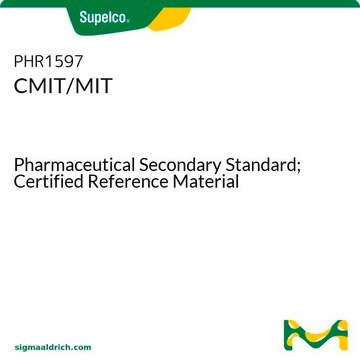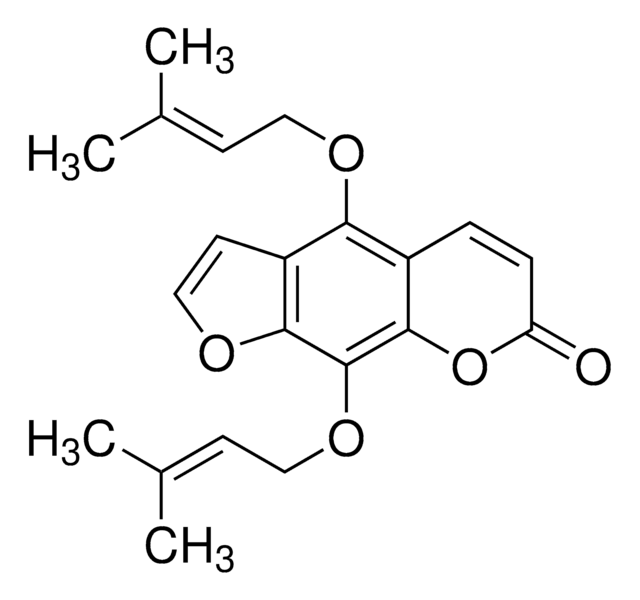推薦產品
一般說明
Methylisothiazolinone, also known as 2-Methyl-4-isothiazolin-3-one, belongs to the group of isothiazolinones. 2-Methyl-4-isothiazolin-3-one is utilized in cell biology and biochemical applications to effectively prevent the growth of bacterial contaminants, ensuring the purity of cell lines.
應用
Methylisothiazolinone (MIT) has been used:
- in research on the effects of the N-methyl D-aspartate (NMDA) receptor antagonist kynurenic acid on human cortical development [1]
- as a cytotoxic substance to investigate its effect on bronchial epithelial cells (BEAS-2B cells) and its role in apoptotic cell death
- to research the effects of tyrosine phosphorylation on focal adhesion kinase (FAK) activity in the development of neural axons and dendrites
生化/生理作用
Mode of Action: Inhibits the growth of microorganisms by disrupting the normal function of microbial cells and interfering with essential cellular processes
特點和優勢
- Ready available solution reduce the need for preparation time
- Commonly used in Cell Biology and Biochemical applications
- High quality antibiotic suitable for mulitple research applications
其他說明
For additional information on our range of Biochemicals, please complete this form.
訊號詞
Warning
危險分類
Aquatic Chronic 3 - Eye Irrit. 2 - Skin Irrit. 2 - Skin Sens. 1
儲存類別代碼
12 - Non Combustible Liquids
水污染物質分類(WGK)
WGK 2
閃點(°F)
Not applicable
閃點(°C)
Not applicable
從最近期的版本中選擇一個:
Eun-Jung Park et al.
Toxicology in vitro : an international journal published in association with BIBRA, 62, 104661-104661 (2019-10-21)
Methylisothiazolinone (MIT) has been used in wide spectrum of fields due to its ability to inhibit microbial proliferation with low toxicity. Meanwhile, in Korea, the concern about the hazardous effects of MIT was amplified by the occurrence of patients that
Shen Du et al.
The Journal of neuroscience : the official journal of the Society for Neuroscience, 22(17), 7408-7416 (2002-08-28)
Neurodegenerative disorders in humans may be triggered or exacerbated by exposure to occupational or environmental agents. Here, we show that a brief exposure to methylisothiazolinone, a widely used industrial and household biocide, is highly toxic to cultured neurons but not
Zhengxi Wei et al.
Toxicology letters, 338, 67-77 (2020-12-09)
Chemical-peptide conjugation is the molecular initiating event in skin sensitization. The OECD test guideline uses a high-performance liquid chromatography/ultraviolet (HPLC/UV) detection method to quantify chemical-peptide conjugation in a direct peptide reactivity assay (DPRA), which measures the depletion of two synthetic
Erol Capkin et al.
Chemosphere, 182, 720-729 (2017-05-23)
Triclosan (TRC), chloroxylenol (PCMX) and methylisothiazolinone (MIT) have been commonly used as an antimicrobial in soaps while borax (BRX) is used in household cleaning. After using these chemicals, they are washed down drains and getting into the aquatic ecosystem in
M D Lundov et al.
The British journal of dermatology, 165(6), 1178-1182 (2011-07-23)
In the early 2000s the preservative methylisothiazolinone (MI) was released as an individual preservative for industrial products and, in 2005, it was permitted for use in cosmetic products. Up until then MI had been used only in combination with methylchloroisothiazolinone
Active Filters
我們的科學家團隊在所有研究領域都有豐富的經驗,包括生命科學、材料科學、化學合成、色譜、分析等.
聯絡技術服務






